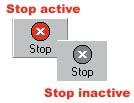It happens quite often that when a page starts downloading, you will decide that either you don’t want or don’t need the page, or that you have got all the information from the first few lines on the page and that there is no need for the page to continue downloading until the end. You would then press the ‘Stop’ button, thus halting the downloading process.

Alternatively, the page may be taking a long time to download and may appear ‘stuck’. By pressing the Refresh button (or Reload) in the case of Navigator,…![]()
…the downloading process is stopped and a new download process is started. The Refresh button reloads a new version of the web page from the server and not a previously loaded version from your computer’s memory or cache.
A cache is a storage place on your hard drive where elements from a web page (text, graphics,etc.) are stored so that the next time you revisit the page, the page elements are not downloaded again from the web but are instead recalled from your hard drive, thus speeding up your web activities considerably. These cached elements may be reused several days or even weeks later when you revisit the web page. The problem with this is that in the meantime, certain elements on the web page may have changed and for this reason, pages are not always the most up-to-date.